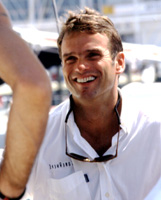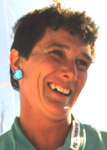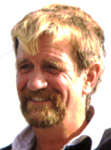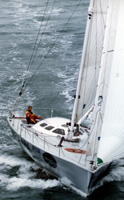 Marc Thiercelin © Foto Billy Black
Marc Thiercelin © Foto Billy BlackTo be successful in solo around the world sailing race one must master the knowledge not only of the weather itself, but also of the world's climate system, especially where it influences the first leg.
So that everyone can understand the reasons influencing a racing sailor's decision in selecting his or her tracks, it is necessary to get familiar with weather system on both North and South Atlantic. To get from Charleston to Cape Town it is not enough to set your boat on Southeastern course. The shortest way is unfortunately not the fastest for sailing vessels. The major limitation of sailboats is that they cannot go directly into the wind. To get to a destination as fast as possible, a sailor must plot the course in such way, that he sails in areas of favorable wind direction while avoiding areas of high pressure where there is no wind at all. Low-pressure systems have strong stormy winds and heavy sea. To sail in vicinity of a low is not comfortable, but it is fast, so long as you are on the side with favorable wind direction. To beat today's ocean-crossing records, sailors are actually trying to hang on to a low-pressure system and travel with it for as long as possible.
Just a few degrees south of Charleston on latitude 30N there is an imaginary line between two masses of air traveling in opposite directions. North of 30N there are westerly winds favoring sailing in easterly direction. The farther north from the line the stronger the winds. South of 30N the winds come from easterly direction and are called Northeast Tradewind and once again, the further south the stronger the wind but only down to a certain latitude.
South of those tradewinds there is a belt of no wind called Doldrums. This wedge shaped belt, wider on eastern end and narrowing on its western side, crosses the whole Atlantic from Africa to Brazil few degrees north of the equator. The Doldrums were always a disaster area for sailing ships due its turbulent, hard-to-predict weather.
South of the Doldrums are strong Southeast Tradewinds blowing almost from Cape Town straight to the northwest. There is also a high-pressure system to avoid in the middle of South Atlantic Ocean. Once south of 40S latitude, favorable and strong westerly winds can be found all the way to Cape Town and farther.
Sailing boats heading for Cape Town from Charleston should stay on the same or slightly northerly latitude and go straight in the easterly direction using the westerly winds. They should go as far as 065W longitude but no further so as to avoid the center of the prevailing no wind high pressure system sitting between the westerly winds and Northeast Tradewinds. Then skippers should turn southeast using the fresh Northeast Tradewinds to get to their preferred crossing point of the Doldrums.
Selecting crosspoint for Doldrums is a tricky job. You do not want to be too far east, because the belt is wider there and it will take longer to cross it. You also do not want to be to far west. The belt is narrower there, but once you cross it you face very light adverse winds and very strong adverse current running along the Brazilian coast. Tacking against the such wind and current will quickly take you nowhere. Crossing the Doldrums is basically jumping from under one cloud to the vicinity of another in the southerly direction, hoping to take advantage of the scant wind puffs that each provides.
Once you cross the Doldrums, far enough to the east, you get into the fresh Southeast Tradewinds. You gain speed but you must head on one tack close to wind for about 2500 miles to get further south. Expect a hard beating with lots of spray flying over the deck. Constant walking on sloping deck may force you to grow one leg longer but by the end the tack, which will take you through a rough semicircle, you get into the far south area of roaring forties with strong and favorable westerly winds.
Of course, these conditions are constantly changing with the time of the year and the highs and lows are constantly moving so one needs not only good knowledge and experience of the whole weather and climate process, but also a great deal of good luck.
It was difficult to predict who made a better decision in the race. Thiercelin and Isabelle still could have gotten stuck with light adverse wind and strong adverse current. Broken forestay would be a big headache for Isabelle once she reaches strong SE Tradewinds. Soldini, being more east still, could compensate for his losses.
 Marc Thiercelin © Foto Billy Black
Marc Thiercelin © Foto Billy Black
Thiercelin continued to hold the lead, followed by Golding. Josh Hall was in third followed by Isabelle. The other top boats were experiencing the horrible slapping of windless sails. Golding was averaging 7 knots and the others were still except for Soldini who picked up 45 miles on the leader. But Golding lost the masthead instruments which provide crucial source of information. A big wave ripped a three-foot hole in his genoa clew.
 Isabelle Astissier © Foto Billy Black
Isabelle Astissier © Foto Billy Black
Autissier had a different trouble: "God, I spent four hours last night trying to
reset the stay without success, it is very difficult to get the tension right. So, I have
lost time for nothing, and I have a dreadful package of lines at the bow, not very
efficient. I will start again from zero tomorrow. It is absolutely necessary that I arrive
at something because at the moment not only am I losing ground because of my speed but
also because I cannot go exactly in the direction I would like to. Nevertheless the boat
continues to advance in these light airs. I am getting a little blue because this is
rather physical work. Last night there was only light air, definitely the Tradewinds will
not tire us out this year. The gennaker is missed very much."
In Class II, JP held a six-mile over Garside. Mouligne had an extremely slow last 24 hrs. "I had been becalmed most of the night, making zero progress. Boat was rocking back and forth with the swells, shaking the sails to death." He had a good testing of his nerves. He was got on deck only to see that the breeze was gone, so he went back down below. He did it 20 or 30 times during the night and he was beat. He was talking with Isabelle Autissier last night and she too was moving very slowly. As a matter of fact, all the lead boats were just crawling along and were slowly being caught up to by the ones behind them.
 Michael Garside © Foto Billy Black
Michael Garside © Foto Billy Black
Michael Garside complained: "No wind, and what ever you do, you get nowhere. No amount of money spent, nor any amount of preparation, determination and experience can make that boat go forward. In the last 24 hours the two slowest boats in the fleet have been Cray Valley and Magellan Alpha. We wallow around alongside each other at the end of the period, just as we did at the start… Race leader Marc Thiercelin was just eighty miles ahead, he now has an advantage of 288 miles… JP and I were right up there with them, now we are in a different weather pattern… As far as I am concerned, when the wind returns the race starts again. And I might just take up kite flying when I get home. At least then I will be able to go and do something else more productive or enjoyable on a windless day."
 Magellan Alpha
Magellan Alpha
Place |
Skiper |
Boat |
Latitude |
Longitude |
Dist. to go |
Speed |
Dist. to first |
Time |
1 |
Thiercelin |
Somewhere |
14 32N |
045 09W |
4646 |
5.5 |
0 |
2140 |
2 |
Golding |
Team Group 4 |
16 57N |
043 32W |
4671 |
2.1 |
24.5 |
2140 |
3 |
Hall |
Gartmore Inv.Mg |
16 14N |
044 45W |
4695 |
1.6 |
48.3 |
2140 |
4 |
Austissier |
PRB |
15 19N |
046 15W |
4725 |
0.7 |
78.5 |
2140 |
5 |
Soldini |
Fila |
23 23N |
043 46W |
4938 |
13.1 |
291.3 |
2140 |
6 |
Reidl |
Project Amazon |
24 26N |
047 29W |
5132 |
0 |
453.9 |
1606 |
7 |
Konioukhov |
Mod Univ Human |
23 13N |
057 33W |
5520 |
0 |
842.2 |
1010 |
Place |
Skiper |
Boat |
Latitude |
Longitude |
Dist. to go |
Speed |
Dist. to first |
Time |
1 |
Mouligne |
Cray Valley |
18 01N |
049 10W |
4958 |
1 |
0 |
2144 |
2 |
Garside |
Magellan Alpha |
18 01N |
049 14W |
4961 |
1.6 |
3 |
2144 |
3 |
Van Liew |
Balance Bar |
18 06N |
049 21W |
4969 |
2.8 |
11 |
2144 |
4 |
Stricker |
Rapscallion III |
25 18N |
047 18W |
5159 |
6.9 |
200.7 |
2144 |
5 |
Saito |
Shuten-dohji II |
24 07N |
048 30W |
5162 |
7.2 |
204.3 |
2144 |
6 |
Davie |
South Carolina |
24 00N |
048 45W |
5168 |
7 |
210.6 |
2144 |
7 |
Petersen |
No Barriers |
23 54N |
050 05W |
5221 |
6.5 |
263.4 |
2144 |
8 |
Hunter |
Paladin II |
26 41N |
052 11W |
5415 |
6.7 |
456.7 |
2144 |
9 |
Yazykov |
Wind of Change Rus |
28 21N |
061 46W |
5884 |
8.1 |
926.4 |
2144 |
© Richard Konkolski
Return back to First Leg